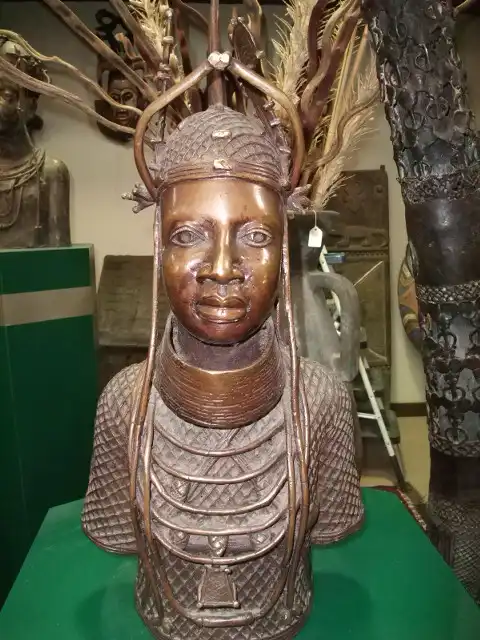
Share This article

Xanadu, a cherished establishment in Santa Fe for over 20 years, proudly houses a remarkable collection that includes the Benin Bronze Princess Bust. Join us on a journey to uncover the beauty and cultural significance of this iconic sculpture, exploring its intricate craftsmanship, historical background, and why it’s a treasure in African art.
The Benin Bronze Princess Bust is a stunning sculpture, standing about 20 1/2 inches tall, 11 inches wide, and 8 inches deep. It’s made of bronze and depicts a princess dressed in elaborate traditional clothing. The craftsmanship is extraordinary, showing detailed patterns and a serene expression that reflects the skill of Benin artisans from the 16th century.
Benin bronze sculptures like this one were created using a special method called lost-wax casting. Artisans first made a model from beeswax, covered it in clay, and then heated it to melt the wax away, leaving a mold. Molten bronze was poured into this mold to create the final sculpture, ensuring every detail was captured and preserved for generations.
The Benin Kingdom, in what is now Nigeria, thrived from the 13th to the 19th century and was known for its advanced culture and art. Benin bronze casting was a significant part of this culture, not just as art but also as a symbol of power and respect for their kings.
When Europeans arrived in the late 1800s, they were amazed by Benin’s wealth and sophistication. Unfortunately, during a British military expedition in 1897, many Benin bronze artworks, including the Princess Bust, were taken away. These sculptures ended up in museums and private collections around the world, sparking debates about cultural heritage and whether they should be returned to Nigeria.
The Princess Bust isn’t just a beautiful artwork; it carries deep meaning in Benin culture. Every detail, from her clothing to the symbols on her body, tells a story. For example, coral beads around her neck symbolize royalty, while leopard motifs on her dress represent strength and leadership.
In Benin’s beliefs, bronze sculptures like the Princess Bust weren’t just decorations; they had spiritual importance too. They were believed to connect the physical world with the spiritual one, making them essential in ceremonies and rituals.
Over time, many Benin bronze sculptures found their way into museums worldwide, such as the British Museum and the Metropolitan Museum of Art. These museums now play a crucial role in preserving and sharing Benin’s cultural heritage with people from all over the globe.
Recently, there have been calls to return these artworks to Nigeria, where they belong. Supporters argue that it’s essential to honor Benin’s history and culture by bringing these treasures back to their place of origin.
The Benin Bronze Princess Bust at Xanadu stands as a testament to the brilliance of Benin artistry, captivating viewers with its beauty and historical significance. It reminds us of the rich cultural heritage of the Benin Kingdom and the enduring legacy of its artisans.
Xanadu continues to honor this legacy by preserving and sharing the Princess Bust and other Benin bronze sculptures with visitors. They serve as reminders of Africa’s artistic prowess and cultural resilience, sparking conversations about history, identity, and the importance of cultural preservation.
As we appreciate the Benin Bronze Princess Bust, we’re invited to explore a world where artistry knows no boundaries—a world where each sculpture tells a story of craftsmanship, symbolism, and the enduring spirit of a kingdom lost in time.
Benin bronze sculptures were crafted by skilled artisans in the Benin Kingdom, showcasing their artistic talent and cultural values. They were often made to honor kings or commemorate important events.
Artisans used a technique called lost-wax casting. They sculpted a model from beeswax, covered it in clay, heated it to melt the wax, and poured molten bronze into the mold. This process allowed them to create detailed and durable sculptures.
Benin bronze sculptures are crucial because they represent the artistic achievements and cultural traditions of the Benin Kingdom. They offer insights into their society, beliefs, and craftsmanship, making them invaluable pieces of African heritage.
Benin bronze sculptures are displayed in major museums worldwide, including the British Museum and the Metropolitan Museum of Art. They’re also proudly showcased at Xanadu Santa Fe, providing visitors with a chance to admire these masterpieces up close.